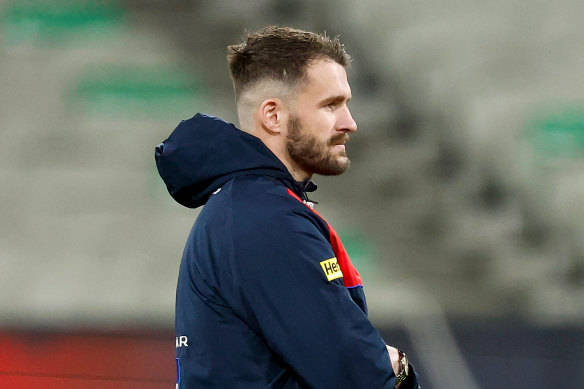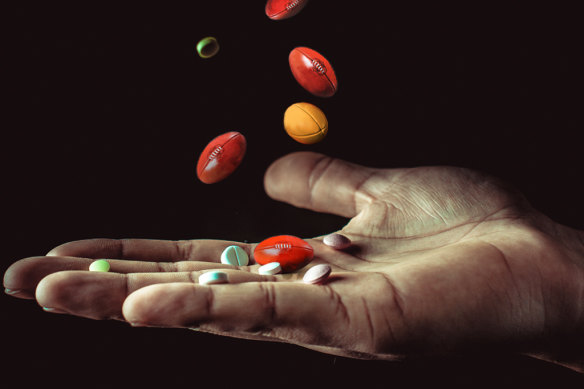Under the AFL’s illicit drugs policy, Melbourne’s Joel Smith would record a first strike, receive a suspended fine and counselling. Here’s what happens under the league’s anti-doping code.
Save articles for later
Add articles to your saved list and come back to them any time.
The revelation that Melbourne’s Joel Smith tested positive to cocaine after a urine test on match day and has been provisionally suspended under the AFL’s anti-doping code has reignited talk about the effectiveness of the AFL’s separate illicit drug policy, which is still being reviewed by the league and the players’ association.
That review, expected to be completed within 12 months, will consider recommendations arising from the AFL illicit drug policy review and position development report.
Melbourne’s Joel Smith has tested positive, in competition, to cocaine.Credit: Getty Images
Smith’s positive test was a result of the AFL’s adherence to the anti-doping code which runs separately to the AFL’s illicit drugs policy.
If a player tests positive to an illicit drug under the AFL anti-doping code then they face a two-year ban if it’s in competition and a three-month ban if out of competition.
Smith tested positive after playing against Hawthorn in round 23, and thus in competition, but under new World Anti-Doping Agency rules introduced in 2021 an athlete testing positive to cocaine or marijuana will only face a three-month suspension if they can prove “the substance was used out-of-competition and that its use was unrelated to sporting performance”.
He would need to prove his case at a hearing of the AFL’s anti-doping tribunal and could have his suspension reduced to one month under the AFL’s anti-doping code if he agreed to undergo substance-of-abuse treatment.
Under the AFL’s illicit drugs policy, which is a medical model geared to player wellbeing, Smith would merely record a first strike, receive a suspended $5000 fine and counselling. He would also be target tested.
If he received a second strike, he would be publicly named but the naming of Smith on Thursday was related to his adverse analytical finding.
While Smith’s case does not fall under the illicit drug policy, the AFL’s approach remains contentious.
Illicit drug policy has critics
For some such as Nick Riewoldt, AFL anti-doping code is not the issue. He stated last year that elements of the AFL’s illicit drugs policy made it ineffective. He was St Kilda skipper during Sam Fisher’s 228-game career with the Saints, a former player who faced drug charges, saying that drugs were creating issues for some players after they left the game. (Fisher finished in 2016.)
Credit:
Riewoldt did not think that the policy, updated seven seasons ago, was enough of a deterrent for players to stay away from drugs.
“I think the policy that exists is one that allows players ‘wiggle room’ to allow the players to be able to tap into those things,” Riewoldt told Fox Footy.
So, what is the policy? And what wriggle room is Riewoldt talking about?
Why was the AFL’s illicit drug policy introduced?
In 2004, Carlton players Laurence Angwin and Karl Norman arrived at training under the influence of the party drug ecstasy. After much outcry and debate, the next year the AFL, through ASADA (the body responsible for administering testing across sports which is now Sport Integrity Australia) began to randomly test players for 44 weeks of the season for illicit drug use out of competition.
The AFL Players’ Association agreed to the AFL’s move as long as it was designed to protect the health and well-being of players rather than to be used as a punitive measure. The policy was based on a medical model that prioritised treatment over suspension, with an acknowledgment that players may be susceptible to drug issues due to their age, income and how their time was spent outside the game.
Under the original policy, players could be suspended only if they tested positive three times – this became known as a three-strike policy. Only one player, former Hawk Travis Tuck, has recorded three strikes since the policy was introduced, with Tuck suspended for 12 weeks in 2010.
In 2013, it emerged that 20 players through 2012 had used a self-reporting loophole to avoid a strike – they admitted to possible drug use before being tested and were given counselling and nothing more.
In 2015, amid claims drug use was rife among players and with clubs fuming that they were kept in the dark if there was a problem (see below), the AFL and players’ association agreed to revise the policy.
How does the policy work?
The illicit drug policy is different to the AFL’s anti-doping code, which focuses on match-day testing that players randomly undergo for performance-enhancing drugs. Illicit drug testing focuses on recreational drug use, although a player testing positive to an illicit substance on a match day also triggers a violation under the AFL’s anti-doping code, and they may be subject to a three-month ban under revised WADA rules introduced in 2021. Testing under the AFL’s illicit drugs policy has focused on substances including cocaine, ecstasy and amphetamines such as ice, and sedatives such as ketamine and GHB. Both kinds of test are administered by Sport Integrity Australia under the auspices of the AFL.
Under the illicit drug policy, AFL medical directors and the player’s club doctor – but not club management – are told of a positive first test. (More on that below.) It gets referred by the AFL medical officer to the club doctor to determine the best course of action, including what treatment the player should be referred to. What happens next is case by case: between player and doctor, and depending on all the circumstances and diagnosis.
A first strike sparks a suspended $5000 fine, counselling and target testing (where a player identified as a potential user is tested more often) but the player remains anonymous.
When a video circulates of a player allegedly taking illicit drugs such as occurred when footage appeared in 2018 of former Giant Shane Mumford out in 2015 it is assumed a strike is recorded, but the information is not made public. Mumford expressed remorse, apologised, was suspended for two matches and committed to rehabilitation and counselling through the club and league’s programs after the incident.
Upon a second strike, a player’s name is made public, and he serves a four-match suspension.
A third strike incurs a 12-match suspension. Strikes must be given within four years of each other to be considered second, third or subsequent strikes.
No player has been suspended or named publicly after recording a second strike since the revised policy was introduced in 2015.
There are now no official testing results released to the public, which means supporters are unaware of the prevalence of drug use among players.
What is the ‘wiggle room’ Riewoldt
appears to be referring to?
The most controversial component of the policy is the clause allowing players who receive a strike to enter a medical program that sees them receive counselling and be target-tested. This means they do not record further strikes if they test positive again while in the program. To enter the program, players must prove to an independent doctor that they have a mental health or other medical issue that led to their drug use.
The program was introduced to protect players with mental health issues, but some in the industry feel it allows those issues to be used as a shield for illicit drug use. “I’ve been criticised for saying this in the past, that players that take drugs take them because they can,” Riewoldt said.
There’s another potential one-off loophole under the policy: players are allowed to self-report, and thus not record a strike, once in their career.
What are AFL clubs told about the drug use?
The illicit drug policy was revised in 2015 so that more information was given to clubs about the extent of drug use in their team. But club CEOs and football managers don’t receive the names of players who test positive. Instead, they are provided with a de-identified report of the amount of drug use at their club. They are told the total number of positives; the number of players within the club receiving treatment after testing positive as a result of underlying mental health issues; and a breakdown, in percentage terms, of what substances have been detected. They are also provided with a comparison of the club’s situation over the past five years.
Clubs can organise extra testing if required, but they still will not be privy to individual information.
Data from both hair testing (which can show if an individual has used illicit drugs in the past three months) and urine testing identifying individuals who test positive is provided to the club’s doctor throughout the year, so they can monitor an individual’s situation and work with players when issues arise.
An AFL source claimed the testing was so extensive it was impossible for a player to avoid eventually being caught. However, this was disputed by several sources, particularly with COVID-19 impacting testing and limited testing of players while they were in hubs.
How prevalent is drug taking then?
It depends on who you ask – and believe. One well-placed industry source said it was consistent with the amount of drug use in the same age demographic as AFL players, although players’ disposable incomes and ability to access illicit drugs is higher than the average person in their 20s.
According to the 2019 National Drug Strategy Household Survey, an estimated 3.4 million (16.4 per cent) of people aged over 14 had used an illicit drug in the previous 12 months, up from 13.4 per cent in 2007.
Former Collingwood chief executive Gary Pert, who is now with Melbourne, once claimed there had been “volcanic” behaviour through the 2013 pre-season.
Riewoldt claimed in 2019 the “free-for-all” situation is “out of control” and on May 23 said it remained an issue among players.
When the AFL reported results of testing under its illicit drug policy from 2005 to 2009, the number of positive tests recorded fell to fewer than one per cent of the total tests conducted. However, scepticism about reported results remained high across the industry.
This explainer was first published in 2019 and has been updated to reflect recent developments.
If you'd like some expert background on an issue or a news event, drop us a line at [email protected] or [email protected]. Read more explainers here.
Most Viewed in Sport
Source: Read Full Article

